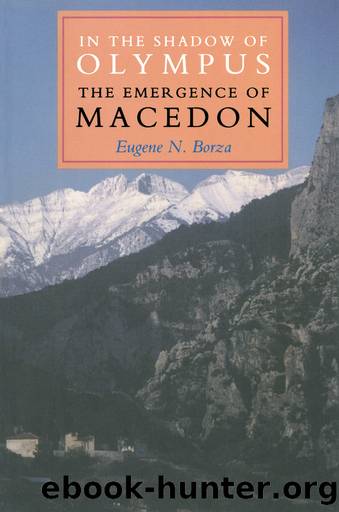In the Shadow of Olympus by Eugene N. Borza;

Author:Eugene N. Borza; [Borza;, Eugene N.]
Language: eng
Format: epub
ISBN: 9780691215945
Publisher: PrincetonUP
Published: 2020-07-15T00:00:00+00:00
Archelausâs Death and the Struggle for Succession
Archelaus met his death in 399, accidentally killed by his lover Craterus during a hunting expedition, according to Diodorus.36 The story might have been unquestioned were it not for another version found in Aristotle (Pol. 1311b.11-12), whose authority as one closer in time and place to these events must be given consideration. The context of Aristotleâs comments about the incident is that some kings suffer as the result of their own shameful activities. He then proceeds to tell of intrigue among the young men of the court, culminating in the murder of Archelaus by Crataeus (Craterus in Diodorusâs account; see note 36 above). A loverâs quarrel and political ambitions play a role, and the episode is complicated by a hint of foreign conspiracy, as one of the schemers against the king is Hellanocrates of Larisa. Hellanocrates was also a lover of Archelaus; the king had promised, but failed, to restore him to his home, while continuing to exploit him physically.
For Aristotleâwhose version is to be preferredâthe assassination is triggered by both political and personal reasons.37 There are elements in the story that recall other Macedonian plotsâfor example, the murder of Philip II and the conspiracy of court pages against Alexander during his Asian campaign. Carney has offered a compelling analysis of common themes: an insecure system of primogeniture, a kingship based on personal (as opposed to institutional) power, and a court filled with intrigue resulting from institutional pederasty. If one adds the competition for marriage into the royal family and the use of royal children for political marriages, the result is an unstable mixture. When political and personal motives became virtually indistinguishable, conspiracy to commit murder could result.
The six years following the death of Archelaus saw what can best be described as a dynastic struggle.38 The conflict raged between the branches of the Argeadae that descended from Perdiccas, Menelaus, and Amyntas, the sons of Alexander I (see genealogical table, p. xviii above). Two other lines failed to survive, those of Philip (wiped out by Perdiccas and Sitalces) and Alcetas (probably destroyed by Archelaus). Orestes, the son of Archelaus and Cleopatra (otherwise unknown, but a prominent female Macedonian name), succeeded to the throne at his fatherâs death. As a minor, he ruled under a regent, Aeropus (his uncle?), who seems to have usurped the throne ca. 398/7. We know that Aeropus was still ruling in mid-summer 394, when he came into conflict with the Spartan commander Agesilaus. We have already seen that the Spartans had opposed Archelausâs intervention in Thessaly ca. 400 B.c. When the Spartans undertook their campaigns against the Persians in Asia and needed to move armies across the land route through Thessaly and Macedonia, they found Macedon unfriendly. Later, when Corinth revolted against Spartan hegemony, Aeropus sided with the rebels and confronted Agesilausâs army, but was outwitted and forced to make a treaty with Sparta.39 There is no further evidence concerning Aeropusâs policies, but it would seem that he and the Thessalians shared an effort to obstruct Agesilaus in their northern part of the world.
Download
This site does not store any files on its server. We only index and link to content provided by other sites. Please contact the content providers to delete copyright contents if any and email us, we'll remove relevant links or contents immediately.
| Africa | Americas |
| Arctic & Antarctica | Asia |
| Australia & Oceania | Europe |
| Middle East | Russia |
| United States | World |
| Ancient Civilizations | Military |
| Historical Study & Educational Resources |
The Dawn of Everything by David Graeber & David Wengrow(1567)
The Bomber Mafia by Malcolm Gladwell(1519)
Facing the Mountain by Daniel James Brown(1428)
Submerged Prehistory by Benjamin Jonathan; & Clive Bonsall & Catriona Pickard & Anders Fischer(1375)
Tip Top by Bill James(1291)
Wandering in Strange Lands by Morgan Jerkins(1280)
Evil Geniuses: The Unmaking of America: A Recent History by Kurt Andersen(1269)
Red Roulette : An Insider's Story of Wealth, Power, Corruption, and Vengeance in Today's China (9781982156176) by Shum Desmond(1267)
The Way of Fire and Ice: The Living Tradition of Norse Paganism by Ryan Smith(1258)
Driving While Brown: Sheriff Joe Arpaio Versus the Latino Resistance by Terry Greene Sterling & Jude Joffe-Block(1230)
American Kompromat by Craig Unger(1213)
F*cking History by The Captain(1196)
It Was All a Lie by Stuart Stevens;(1191)
American Dreams by Unknown(1153)
Treasure Islands: Tax Havens and the Men who Stole the World by Nicholas Shaxson(1151)
Evil Geniuses by Kurt Andersen(1142)
White House Inc. by Dan Alexander(1122)
The First Conspiracy by Brad Meltzer & Josh Mensch(1075)
The Fifteen Biggest Lies about the Economy: And Everything Else the Right Doesn't Want You to Know about Taxes, Jobs, and Corporate America by Joshua Holland(1029)
